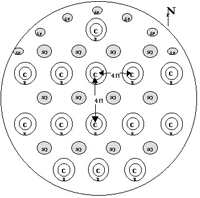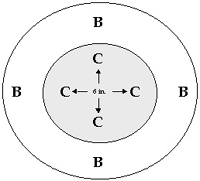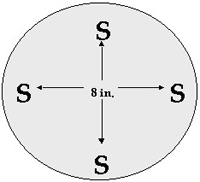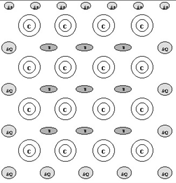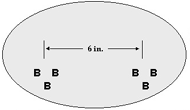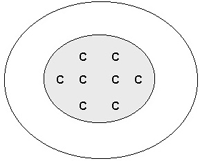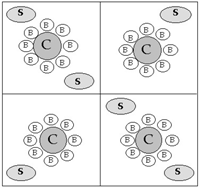

Chapter 18
–Garden–
Excerpted from Out Of Harm's Way 1 Edited by Kenneth D. Nunn ©2011
A garden should be a very important part of your survival plan. A garden large enough to supplement the diet of a large Group will not be hard to plan and maintain. The only extra supplies you will need is seed.
Seed should be chosen carefully. Of course, you want to make sure the plant seeds you have in your cache are plants that will grow at the evacuation point, in other words make sure they are compatible to the climate. You will need to consider such things as altitude, rain fall, and length of growing season.
First of all chose an area of ground that will be easy to clear of brush and grass. Make sure it will get sunshine at least six hours a day. It should also be a well-drained location and not in a flood prone area.
The main problem you will have is animal and bird control. Animals such as squirrels, mice, and birds will sometimes dig out your seeds. Once the plant breaks the ground, rabbits and deer may eat them. Then after the plants start producing all the animals and birds will be a problem. A couple ways in which to fight this is with some type noisemaker or maybe a scarecrow.
Sometimes a piece of cloth or something blowing in the wind will scare them off. Perhaps the best method of scaring wild life will be using a dog. A dog will usually bark and chase anything that gets in the garden. The Native Americans use to solve this problem by letting the young boys guard the plants day and night.
I have included three articles that I feel will be very helpful in a long term survival situation. There is no doubt you will require a garden. With few exceptions, you will be required to garden with only the basic tools. With this in mind I have chosen three articles featuring three Native Americans concepts of gardening. Begin with “The Three Sisters,” “The Companion Planting," and “Zuni Waffle Garden."
–The Three Sisters–
For untold years many of the Native Americans have grown corn, squash and beans. According to Iroquois legend, corn, beans, and squash are three inseparable sisters who grow and thrive together. They believe these three crops are special gifts from the Great Spirit.
The original concept of the "Three Sisters" incorporated the planting of corn, beans, and squash in a single mound or bed. In this way, each plant benefited the others. The cornstalk supports the climbing bean vines. The beans help replenish the soil with needed nutrients. The squash provides a number of advantages to the Sisters. The large squash leaves shade the mound inhibiting the growth of weeds, conserves water by slowing evaporation. It is also believed that the spines on the squash plant helps in keeping raccoons from helping you harvest your crops. Personally I find it hard to believe that raccoons would let these spines slow them down.
The "Three Sisters" are believed to be the first crops that were cultivated by many of the Native American tribes. All three of these crops have been found in the ruins throughout the Americas, Mesa Verde in Colorado, Chaco Canyon in New Mexico, Range Valley in Utah, Chichen Itza, and the Mayans ruins throughout Mexico.
The modern day concept of the "Three Sisters" is referred to as companion planting. Companion plants are where two or more different type plants are planted in close proximity to each other. In this way the plants benefits each other in some way; corn provides a location for the bean vines to grow, beans provide nutrients needed by other crops, squash provides shade and etc. Companion planting is usually down on a small scale. In modern times the concept has been expanded to include many other plants. The "Three Sisters" concept of gardening is ideal for a long term survival situation. It is a proven method of gardening, making it ideal for a garden in a survival situation. This method was a major contributing factor for the survival of the Native Americans.
One of the major advantages of this method of gardening is its small foot print. Grown as a group these plants will provide high yields with minimal space and cultivation.
To be successful there are four points that should be considered :
• Choosing the right plants
• Plant correct varieties of plants
• The proper time to plant each type plant
• The proper location
Another important point to consider is fertilizer. The Native Americans usually used fish as a means of fertilizing their crop. However, to be of much benefit the fish was placed in the mounds the previous year. In a survival situation the use of leaf mulch worked into the mound will give a more imitate benefit.
–Correct Plant–
–Corn, Beans, Squash–
All survival gardens should include corn, beans and squash. A variety of these three plants will grow throughout the United States. Corn, beans and squash combine to create a nearly perfect meal loaded with essential vitamins and minerals.
–Beans–
Beans provide a high-quality protein food source that combines well nutritionally with corn. Beans also play a valuable role in the "Three Sisters" garden. Through a symbiotic relationship with rhizobium bacteria, beans help to take nitrogen from the air and convert it into a usable form for next year's crop.
Pole beans are best adapted to directly climb the corn stalks, as opposed to sending runners across the ground.
Scarlet Runner is a popular heirloom pole bean that is famous for its large cluster of bright red flowers.
Genuine Cornfield consistently produces in the heat of Southern summers.
True Cranberry a dark red bean with a meaty texture and a nutty chestnut-like flavor, also performs well in the South and in the Northeast.
Cornfield, not related to Genuine Cornfield does well in the Pacific Northwest because it matures before the fall rains come.
Hopi Purple a favorite in the arid Southwest is a purple bean with black crescent moon strips.
–Corn–
Corn is the basic plant of the "Three Sisters" garden. It is considered to be the most important of all Native American crops. The variety of corn you use in your garden should be carefully chosen. The tall, sturdy heirloom varieties work best because they are capable of supporting the beans. Traditionally, most of the corn grown by Native Americans is dry field corn, which is used in flour production. One of the biggest advantages of this type corn in the survival garden is that it is harvested late in the season when the ears have dried on the stalk.
Dry field corn is divided into three categories: dent, flint, and flour corn.
• Dent corns are adapted best to the Southeast and the Midwest. Dent corn has a distinctive dimple-like dent on top of the kernel when it is fully dried. A dent corn that grows well most anywhere in the United States is the Cherokee Blue and White. Reid's Yellow Dent can also be widely grown.
• Flint corn grows best in the northern plains region. The kernels of flint corn do not shrink when they are dry. A popular flint corn is Indian Ornamental with colors ranging from purple to yellow.
• Flour corns usually have thinner-shelled kernels filled with soft white starch. Flour corns were developed in the arid Southwest. They are less likely to succeed in cooler northern regions with short growing seasons and in moist, humid areas where they are susceptible to a fatal rust disease.
• Hopi Pink is a short, drought-resistant corn, with kernels range in color from cranberry to light pink. This variety has plump, thin shelled kernels that grind easily into find flour. A flour corn that works well in northern gardens is Mandan Bride. This variety is also drought tolerant, with red, blue, yellow, pink, and purple spotted kernels.
Corn can be harvested earlier in the season when still "green corn." Green corn is harvested when the corn is still in the "milk" stage, when the kernels are at their sweetest and can be eaten fresh.
–Pumpkin–
Long Pie (Indian or Golden Oblong) are still grown by the Native Americans of the Northeast. It looks like a fat zucchini with the texture of a pumpkin. It has a long shelf life and usually doesn't turn orange until after it is harvested.
Connecticut Field A disease-resistant variety suited for the Southeast. This is a very vigorous Native American heirloom that yields large yellow pumpkins.
–Squash–
Squash grow low to the ground and serve as living mulch. The large leaves block out much of the sunlight, thus reducing weed germination. It is also believed that chemical secretion from squash plants have adverse effect on some weeds. Since we are looking at the "Three Sisters" as a survival garden we will restrict our squash choices to Winter Squash in that winter squash has a long shelf life. Winter squash (such as Butternut, Hubbard, Buttercup, Amber, Acorn, Spaghetti squash, and Pumpkin) are harvested at maturity, generally at the end of summer, cured to further harden the skin. Winter squash, when stored in a cool place will last for months.
Seeds are started after all danger of frost is past and the soil is warm. They can be started inside 3 - 4 weeks before the predicted last frost date. Seeds are placed one inch deep, 5 - 6 seeds to the hill.
Acorn : has distinctive longitudinal ridges and sweet, yellow-orange flesh. It will keep for several months in a cool dry location. Roughly 85 days after germinating, acorn are ready for harvest. Curing takes a week to ten days in a sheltered area outside.
Banana : grows in most regions of the country. Its protective skin turns into a tough harden rind. Very durable and is successfully stored for the entire winter.
Spaghetti : fruit ranges from ivory to yellow or orange in color or green with white streaks. Its center contains many large seeds. Its flesh is bright yellow, orange and white for the latter variety. When raw the flesh is solid and similar to other raw squash when cooked, the flesh falls away from the fruit in strands like spaghetti.
Planting designs and cultivation practices vary according to climatic region. Garden styles were developed mainly out of practical considerations, such as moisture availability, climate, and the length of the growing season. The Wampanoag garden style works well east of the Mississippi. Hidatsa gardens were developed to thrive in the climate of the northern Plains, while the Zuni waffle garden was designed to conserve water in the arid Southwestern climate.
–Wampanoag Three Sisters Garden–
It was the Wampanoag gardens that enabled the early settlers of Jamestown to survive and thrive in the New World. Squanto was a Wampanoag who "taught the newcomers to plant maize in little hills and fertilize each mound with an alewife, a species of fish." With this efficient and intensive gardening style, each family could sustain their needs on about one acre of land. Many of the tribes of the Northeast, including the Iroquois, used the Wampanoag garden design. Planted without plowing or tilling, the traditional Wampanoag garden includes corn, beans, squash, and sunflowers. The corn and beans are planted in mounds, with squash planted between the mounds.
Corn is planted six inches apart in the flat top of the mound. Beans are planted halfway down the slopes on the sides of the mound.
The sunflowers are planted along the north edge of the garden, so that they do not cast a shadow on the other crops (see Figure 1). When the sunflowers have bloomed and the squash and beans have flowered, the Wampanoag Three Sisters garden becomes a stunning cluster of red, yellow, and white flowers against a textured backdrop of shimmering greens.
First, the raised corn and bean mounds must be constructed. These small mounds are laid out in rows with 4 feet between the centers of the mounds (see Figure 1). Each mound is about 4 inches high, with a wide base (about 18 inches in diameter) that narrows to a flattened top (about 10 inches across). To conserve moisture, a depression with a lip may be formed at the top of each mound. The finished mounds have a remarkable resemblance to miniature moon craters.
–Cultivation and Planting Designs–
Figure 1: Circular Wampanoag Garden
Drawing by Mardi Dodson
Concept taken from Native American Gardening
By Michael J. Caduto and Joseph Bruchac
Figure 2: Wampanoag Corn and Bean Mound
Drawing by Mardi Dodson
Concept taken from Native American Gardening
By Michael J. Caduto and Joseph Bruchac
Figure 3: Wampanoag Squash Mound
Drawing by Mardi Dodson
Concept taken from Native American Gardening
By Michael J. Caduto and Joseph Bruchac
When the mounds are ready, plant four corn seeds about 6 inches apart and 3 inches deep in the top of each mound. Once the corn has grown to a height of 4 inches or more, plant four beans seeds halfway down the slopes on the sides of each mound (see Figure 2). Allow the bean vines to entwine themselves around the cornstalks for support. The bean vines may be pruned if they get too aggressive.
Squash seedlings are planted at the same time as the beans. Construct rounded mounds 3 inches high and about 1 foot across at the base. The squash mounds are staggered between the mounds of corn and beans (see Figure 1). Traditionally, four seedlings are planted in the top of each mound.
The seedlings are arranged to represent each of the four sacred directions (see Figure 3). Both winter and summer varieties are planted, including pumpkins, acorn squash, and summer crookneck squash (6). Sunflower seeds are planted at the same time as the corn. The smaller flowering common sunflower, Helianthus annus, is traditionally grown in a Wampanoag Three Sisters garden. The sunflower mounds are located at the north edge of the garden (see Figure 1).
The mounds are spaced about three feet apart from center, with three seeds planted (one seed per hole) atop each mound. The sunflowers seeds are traditionally harvested after the first frost.
–Hidatsa Gardens–
Figure 4: Hidatsa Garden Design
Drawing by Mardi Dodson
Concept taken from Native American Gardening
By Michael J. Caduto and Joseph Bruchac
In the northern plains, the Hidatsa, Mandan, and Arikara peoples gardened along the floodplain of the Missouri River in what is now called North Dakota. Most of the tribes in this region used the Hidatsa garden design (see Figure 4). Hidatsa gardens are designed to have alternating, staggered rows of corn and beans, with sunflowers growing along the north edge of the garden. Squash is planted after every fourth row of corn and beans and around the east, south, and west edges of the garden.
Sunflowers are planted as soon as the threat of frost has passed. As in the Wampanoag garden, three sunflower seeds are planted in small mounds 3 feet apart along the north edge of the garden. The Hidatsa garden differs from the Wampanoag garden when it comes to seed arrangement - all three seeds are planted in one hole. Hidatsa varieties of sunflower produce black, red, white, and striped seeds.
Figure 5: Hidatsa Squash Mound
Drawing by Mardi Dodson
Concept taken from Native American Gardening
By Michael J. Caduto and Joseph Bruchac
Plant squash indoors in peat pots or seed flats when the sunflowers are planted in the garden. Before planting in the garden, prepare the squash mounds (about 15 inches across at the base), with 4 feet between the centers of the mounds. The squash mounds are located along the east, west, and south edges of the garden in alignment with the rows of beans (see Figure 4). Squash seedlings are usually transplanted when they are about 4 inches tall and have put on their first set of true leaves (about two weeks after the corn is planted). To protect them from the heavy spring rains, four seedlings are planted on the sides of the mound in sets of two, 12 inches apart (see Figure 5).
Bean seeds are planted on the south-facing slope of the mound. One seed is planted per hole, with a total of six seeds planted in each mound.
Figure 6: Hidatsa Bean Mound
Drawing by Mardi Dodson
Concept taken from Native American Gardening
By Michael J. Caduto and Joseph Bruchac
In the Hidatsa garden, there are usually four corn mounds per row of corn. Note that the rows of corn are in alignment but are staggered in comparison to the beans (see Figure 4). Hidatsa corn mounds are constructed in the same way as the Wampanoag corn and beans mound. The differences are that only corn is planted in these mounds and eight seeds, instead of four, are planted in the top of each mound (see Figure 7). Growing corn together in bunches offers extra support and protection from wind and rain damage.
Hidatsa flint corn is planted in May in North Dakota when the leaves of the Gooseberry shrubs have emerged and fully formed. Corn is planted a week or two after the sunflowers have been planted. This flint corn is a semiarid variety with a growing season of about 70 days. It is advisable to research which corn variety works best for your zone and climatic conditions. Beans are planted at the same time as corn. In a Hidatsa garden, beans are planted separately from the corn in their own mounds. The bean mounds are located between the rows of corn in a staggered, alternating pattern (see Figure 4). The mounds are rounded ovals, about 4 inches tall by 7 inches wide by 14 inches long. Traditionally, two people worked together to plant beans. The first person made six holes in the south-facing slope of the bean mound. This is done in one swift motion by thrusting both hands into the soil with the thumb and first two fingers extended to make two sets of holes spaced 6 inches apart (see Figure 6). The second person follows behind and plants one seed in each hole. A total of six seeds are planted in each bean mound.
In a Hidatsa garden, eight seeds are planted atop each mound.
Figure 7: Hidatsa Corn Mound
Drawing by Mardi Dodson
Concept taken from Native American Gardening
By Michael J. Caduto and Joseph Bruchac
–Zuni Waffle Garden–
Figure 8: Zuni Waffle Garden
Drawing by Mardi Dodson
The Zuni live in the Four Corners area of the Southwestern United States. This arid climate at altitudes over 7,000 feet makes gardening a special challenge. The Wampanoag and Hidatsa garden designs use raised mounds to keep the root systems from being waterlogged. In contrast, the focus of this garden is water conservation. The waffles are about 12 feet by 12 feet. Each individual square is indented and surrounded by a high rim. In each square, a single crop or combinations of crops may be planted (see Figure 8). This garden design will work anywhere in the country where dry summer conditions are experienced.
Traditionally, the crops are planted intensively with five to eight corn seeds in each hole to create clumps of corn similar to those in the Hidatsa garden. Corn seeds are planted 4-8 inches deep in light sandy soils and about 4 inches deep or less in heavier clay soil. Beans and squash have the same planting depths and spacing requirements as corn. The same numbers of beans (4-8 seeds) are planted around each clump of corn, one seed per hole. Only one or two squash plantings (4-8 seeds in each hole) are added to each waffle (see Figure 8). As with the other two designs, sunflowers may also be planted along the edges of the Zuni Waffle garden. Helianthus maximilianii, a small sunflower with flower heads about 3 inches wide, is most commonly grown in the Southwest.
–Summary–
Native American tribes of North America have made enormous contributions to the foods we eat today. The dynamic trio known as the Three Sisters not only thrives when they are planted together, they offer a well-balanced, nutritious meal. Over the centuries, many plant varieties and gardening styles were developed for each major climatic region. The Wampanoag (Northeast and South), Hidatsa (Plains), and Zuni waffle garden (Southwest) offer a range of gardening styles to accommodate most growing conditions found in North America.
Corn, beans, and squash have a unique symbiotic relationship in a Native American garden. Corn offers a structure for the beans to climb. The beans, in turn, help to replenish the soil with nutrients. And the large leaves of squash and pumpkin vines provide living mulch that conserves water and provides weed control. This ancient style of companion planting has played a key role in the survival of all people in North America. Grown together these crops are able to thrive and provide high-yield, high-quality crops with a minimal environmental impact.
Companion Planting: Basic Concept and Resources
By George Kuepper & Mardi Dodson
©July 2001
National Center for Appropriate Technology
ATTRA - National Sustainable Agriculture Information Service is managed by the National Center for Appropriate Technology (NCAT) and is funded under a grant from the United States Department of Agriculture's Rural Business Cooperative Service. This publication is available for free from the National Sustainable Agriculture Information Service website at this link.
